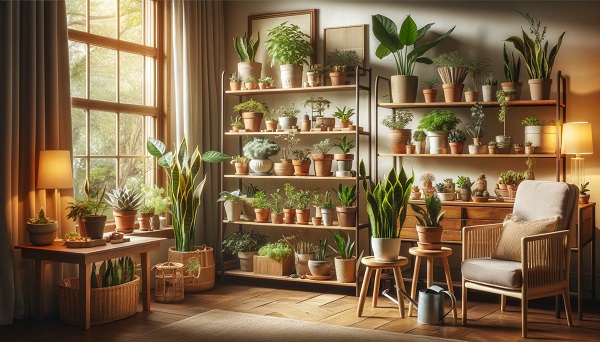
Keep Your Houseplants Alive: A Healthy Indoor Plants Guide
Gersom
- 0
Introduction
Having greenery in your home can change your life. It brings color, purifies air and, if studies are to be believed, makes you feel happier. What’s not to like? Well, keeping it convinced to stay alive, that’s another matter. Turns out, you can be a plant whisperer – and here’s how …
Choosing the Right Plants
Understanding Your Space
First thing’s first: know your environment. Do you have a window that lets in warm morning light, or are your quarters Sarlacc-like? That will dictate which is a candidate and which isn’t.
Lighting Conditions
Not every plant is a sun worshiper, although many are such. Some people prefer plants that thrive only in low light or ambient light, while others prefer plants that require full-day sunbathing. Be equipped with this knowledge while browsing through flowers at the shop so you know what to bring home.
Climate Control
Most houseplants prefer not to have wild fluctuations in temperature or humidity, so try to keep your plant-children as warm or cool as the rest of your home (but away from persistent drafts or heating/cooling vents that make you feel better or worse).
Pet-Friendly Options
Do you have pets? Some plants are toxic to furry family members; check yours out before adding a new green friend.
Potting Basics
Choosing the Right Pot
So, the pot is going to play a huge role here – it has to be the right size, you have to put a hole at the bottom for the drainage… If you have a plant in a wrong size, too big or too small, it can dry off very quickly.
Soil Matters
Dirt is not one-size-fits-all. Match the soil mix with the plant type. Cacti and succulents need a very well-draining mix. Ferns might do well with something more moisture-retentive.
Proper Drainage
Plants do not like having wet feet! Make sure your pot has drainage holes and do not allow the pot to sit in water. Place on a saucer for dripping certainly, but empty it frequently.
Watering Techniques
How Much Water?
Ah, the golden question! It depends on the plant. In general, water when the top inch or so of soil feels dry. Overwatering is very bad because it will drown your plant, while underwatering will let your plant dry out.
Watering Frequency
Water them regularly. How often you water depends on the plant and the season – in the growing season (spring and summer months) they could require watering more regularly than in fall and winter.
Signs of Overwatering and Underwatering
If leaves are yellowing, stems mushy, and soil moldy, then you’re undoubtedly overwatering. Conversely, if leaves become brown, crispy at the edges, and wither, then you’re underwatering. Adjust your watering habits accordingly.
Lighting Essentials
Natural Light vs. Artificial Light
Photo by Bill WadmanWhen there is natural light, this is the best, but not always the case. Use grow lights fulfil the functions in the absence of natural light. They will make a great difference especially in the dark.
Best Spots for Your Plants
Put plants where they’ll receive the amount and type of light they need. The south end of windows tends to be best, but some plants can thrive in east- or west-facing spots too.
Using Grow Lights
If you don’t have enough natural light, consider using grow lights. Just choose the right type and make sure to follow the directions provided by the manufacturer.
Fertilizing Your Plants
Types of Fertilizers
Choose a fertilizer that works for the kind of plant you want to grow (there are lots: liquid, granular, slow-release, etc.), and that matches your watering habits.
When and How to Fertilize
Most plants use more nutrients while they are actively growing. Never put more fertilizer than what your laboratory information says. It is also a good idea to cut down on the fertilizer during the flowering season of summer perennials. Over-fertilizing can burn the roots of your plant.
Pest Control
Common Houseplant Pests
Spider mites, aphids, mealybugs and the like are especially common culprits. Check your plants frequently and you can often nip pest problems in the bud.
Natural Pest Control Methods
Pests can also be kept at bay through the use of neem oil, insecticidal soap, even just a strong stream of water. Avoid using harsh chemicals that can injure your plants and also harm your indoor environment.
Using Insecticidal Soaps
These soaps are nontoxic and effective. I guarantee that if you follow the instructions on the label and apply as needed, the pests will stay far away.
Pruning and Maintenance
Why Prune?
Pruning is helping your plants to stay healthy and also helps them to rebud and reshape again.
How to Prune Correctly
Be sure to use clean, sharp scissors or pruners, and trim a bit above a leaf node so that you stimulate further branching. Remove dead or diseased sections for the continued health of your plant.
Routine Maintenance Tips
Dust frequently, rotate your plants for even growth, and monitor your plants for pests – the little stuff matters.
Repotting Your Plants
When to Repot
Eventually, plants outgrow their pots and need to be transferred to a larger one – move your plants into a new pot every 1-2 years, or when you spot roots growing out of the drainage holes.
How to Repot
Go for a pot that is slightly larger than the one the plant is in now. Take the plant out of the pot and take out some of the roots. Put the plant back in the pot with new soil.
Seasonal Care Tips
Spring and Summer Care
These are the growing seasons. Water more frequently, fertilize, and watch for rapid growth.
Fall and Winter Care
Growth naturally slows down in cold months Water less, fertilize less, and (if necessary) give the plant some extra light.
Troubleshooting Common Issues
Yellow Leaves
This can be from overwatering, underwatering, or nutrient deficiencies. Check your care routine for issues before repotting.
Drooping Plants
Drooping may mean waters tress. Check the soil moisture, and water if necessary.
Stunted Growth
If your plant fails to thrive, maybe they need more light, or extra food, or a bigger pot. Figure it out, and make a change.
Benefits of Indoor Plants
Health Benefits
Plants cleanse the air and reduce stress, but they also increase productivity! Plants are natural mood-boosters.
Aesthetic Benefits
Indoor plants are good for your home’s decoration. For my part, I like true nature in my living room. This is absolutely fantastic and amazing. 2. Yes, indoor plants can enliven your home and turn it into a place where you would like to spend your time. However, honestly, I wouldn’t say they have any special advantages. As for me, I prefer encouraging colorful birds in my window rather than buying exotic plants and plants for my family.
Creating a Plant Care Routine
Daily Tasks
Check soil moisture, inspect for pests, and enjoy your plants!
Weekly Tasks
Rotate plants, clean leaves, and check for any signs of stress or disease.
Monthly Tasks
Fertilize as needed, prune, and repot if necessary.
Final Thoughts
Taking care of your houseplants is not rocket science, but there are a few tricks to nurturing them so that they flourish instead of withering on the vine. Armed with the right information, and a few easy-care varieties, it won’t be long before you have a thriving indoor garden and not a single dead ‘deadly’ Philodendron in sight. Happy planting!
FAQs
How do I know if my plant needs water?
Look in the top inch (2.5cm) of the soil. If it’s dry, water. Pay attention to drooping or wilting leaves.
What are the best low-light houseplants?
Snake plants, ZZ plants and pathos are some that come to mind. All will tolerate their lower light status.
How often should I fertilize my houseplants?
Fertilize every 4-6 weeks during the growing season, spring and summer; cut back or discontinue fertilizer in fall and winter.
How can I prevent pests on my houseplants?
Check your plants often, keep the leaves clean, and try natural pest control with neem oil, insecticidal soap, etc.
What is the best way to clean my houseplants?
Gently wipe away cobwebs and grease marks from the leaves with a damp cloth or give a lukewarm shower. No powerful cleansers please. And water regularly.
Samsung Galaxy S21 iPhone 12 Pro Max Samsung Note 20 Samsung Galaxy A51 LG K40 LG V60 ThinQ iPhone 11 LG Velvet Samsung Galaxy S21 LG Velvet


